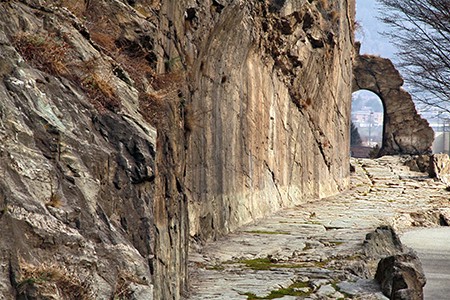Looking at all the commemorative arches adorned with chariots and triumphal emblems in Rome of the first century CE, a contemporary wag scrawled on one "αρκετά!"—"enough!" (Suetonius, Domitian, 13). The Romans erected well over eight hundred arches across the empire. Pervasive and eye-catching, these simple structures became icons of Roman culture, still replicated today, as in the case of the Millennium Gate Museum in Atlanta (2008). Highly decorated, freestanding memorial arches usually had militaristic associations, but only around thirty can be securely associated with an official triumph; the others commemorated different achievements. In previous work I analyzed the construction of the famous arch of Septimius Severus (r. 193–211 CE) in Rome, considering how the act of building disrupted urban activities while simultaneously providing public entertainment. In another publication I examined how the sculptural programs and placement of arches manipulated the movements and memories of ancient viewers. These studies were pebbles thrown into a large pool, creating endless ripples of inquiry. Among the most tantalizing were those lapping at such large questions as: Why were commemorative arches so enduringly pervasive? How did these seemingly simple designs maintain their experiential appeal? Did those in the countryside operate differently from those in cities? Why were arches frequently associated with great engineering projects?
While at CASVA I began a holistic examination of this ubiquitous architectural form, initiating an open-source, geotemporal database of the entire corpus that can be analyzed by date, form, donor, design, scale, materials, and other factors. This will inform several projects, including a book-length study on the deployment of honorific arches to commemorate infrastructure projects. Roman military and engineering operations were inextricably linked. Both were essential to elite male careers; both reflected a strong cultural admiration for organizational prowess, technical proficiency, and paternalism. When in the military, senators acquired logistical skill and technical knowledge building military machines and transportation networks that facilitated troop movements and regional control. Such expertise carried over to subsequent nonmilitary posts, as almost every level of the cursus honorum involved engineering works with potent propaganda value. For Roman leaders, the defeat of a river by erecting a bridge paralleled the defeat of human foes; both deserved enduring recognition. Relatively inexpensive yet attention-grabbing memorial arches were enduring billboards, ever reminding viewers of costly projects undertaken on their behalf. For example, when creating a road through the Alps in the reign of Augustus (27 BCE–14 CE), military engineers cut away a 221-meter section of stone cliff but pointedly left a segment of living rock in the form of an arch to ensure that their achievement would not be forgotten.
The emperor Augustus was the first to deploy honorific arches to memorialize construction works. In republican Rome, statues were elevated above urban crowds atop simple freestanding arches called fornices. Augustus strategically renamed the form, describing those specifically honoring state achievements as arcus. He erected several on bridges and other big engineering projects in the countryside, touting their infrastructural connections with representations on coins. Generally funded by the Senate and people of Rome and the emperor, the memorial arcus proliferated. Every journey along a major Roman imperial highway, every landing at a port was punctuated by carefully choreographed sequences of arches regaling travelers with narratives of state largess. Initial experiential analyses indicate that donors exploited the bidirectionality of arches to provide varied readings. By examining specific roadscapes over time using digital mapping and modeling, I hope to reveal how the addition of new arch memorials integrated evolving imperial agendas while emphasizing the state’s unfailing engineering achievements and paternalism.
My explorations of arches have been greatly enriched by discussions with CASVA colleagues on a wide range of topics, from kinetic viewing and regionalism to materiality and iconicity. The interrogation of ancient descriptions, building and engineering techniques, artistic depictions, communication routes, and imperial administration in the Roman world would have been impossible without the expert help of CASVA research associates and the National Gallery of Art librarians, especially the unparalleled detective skills of the interlibrary loan staff. During my residency I laid out the structure of the book on Roman arches and infrastructure projects and lectured on the topic at the University of Pennsylvania. Simultaneously, my analysis of construction sites as spectacular venues resulted in an article, “Bones for Obelisks” (Seleucia, 2018), exploring Roman deployment of small inserts (astragals) to support giant obelisks re-erected using a vertical lift system, a show-stopping undertaking emulated by Domenico Fontana (1543–1607) when moving the Vatican Obelisk. In addition, this year I completed numerous maps, plans, and other digital illustrations for the forthcoming book Roman Architecture and Urban Design, coauthored with Fikret Yegül (Cambridge University Press).
